Lorem ipsum dolor sit amet, consectetuer adipiscing elit. Maecenas porttitor congue massa. Fusce posuere, magna sed pulvinar ultricies, purus lectus malesuada libero, sit amet commodo magna eros quis urna.
Nunc viverra imperdiet enim. Fusce est. Vivamus a tellus.
Pellentesque habitant morbi tristique senectus et netus et malesuada fames ac turpis egestas. Proin pharetra nonummy pede. Mauris et orci.
Aenean nec lorem. In porttitor. Donec laoreet nonummy augue.
Suspendisse dui purus, scelerisque at, vulputate vitae, pretium mattis, nunc. Mauris eget neque at sem venenatis eleifend. Ut nonummy.
EURCAW-POULTRY-SFA'S THIRD SCIENTIFIC ARTICLE
The Centre is celebrating the publication of its third scientific paper as a result of the work carried out in Activity 3 in 2021 and 2022. The technical study aimed at evaluating the prevalence and the inter-observer repeatability of the most valid and feasible animal-based indicators (ABIs) of the state of consciousness after waterbath stunning (WBS) in turkeys before bleeding (tonic seizure, breathing, spontaneous blinking, and vocalization) and during bleeding (wing flapping, breathing, spontaneous swallowing, and head shaking).
This article named "Relevant Indicators of Consciousness after Waterbath Stunning in Turkeys and Stunning Efficiency in Commercial Conditions" is available here.
Good welfare practices for broiler chicken
Concrete examples of good practices in relation to broiler chicken welfare may inspire poultry producers in the European Union to take up similar practices or implement related initiatives.
In 2021, EURCAW-Poultry-SFA searched for and identified farms and slaughterhouses showing best practices related to broiler chicken.
In 2022, members of the consortium visited a selection of good practices for broiler chicken listed here. The knowledge gained during the visits was used for the final decision on which demonstrators were approved as examples of good practices.
Good welfare practices for laying hen
Concrete examples of good practices in relation to laying hen welfare may inspire poultry producers in the European Union to take up similar practices or implement related initiatives.
In 2021, EURCAW-Poultry-SFA searched for and identified farms and slaughterhouses showing best practices related to laying hen.
In 2022, members of the consortium visited a selection of good practices for laying hens listed here. The knowledge gained during the visits was used for the final decision on which demonstrators were approved as examples of good practices. See below the end product as a factsheet for laying hen.
Good welfare practices for turkey

Concrete examples of good practices in relation to turkeys' welfare may inspire poultry producers in the European Union to take up similar practices or implement related initiatives.
In 2021, EURCAW-Poultry-SFA searched for and identified farms and slaughterhouses showing best practices related to turkeys.
In 2022, members of the consortium visited a selection of good practices for turkeys listed here. The knowledge gained during the visits was used for the final decision on which demonstrators were approved as examples of good practices. See below the end product as two factsheets for turkeys: one at slaughter and one on-farm.
Good welfare practices for rabbit
Concrete examples of good practices in relation to rabbits’ welfare may inspire producers in the European Union to take up similar practices or implement related initiatives. In 2022, EURCAW-Poultry-SFA searched for and identified good practices regarding alternative rabbit production, resulting in a list. The intention is that members of the consortium will visit a selection of these best practices in 2023. The knowledge gained during the visits will be used for the final decision on which demonstrators can be approved as examples of best practices. The end product will be factsheets on best practices of alternative rabbit production.